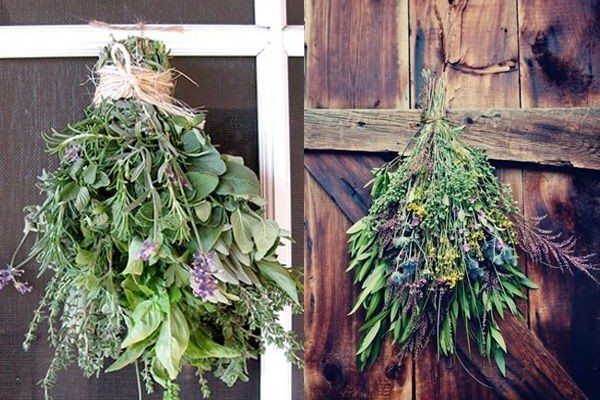By Teresa Opdycke
An herbal wedding says romance — with conviction. Its palette is fragrance, muted colors, and sentimental symbolism. The legend and lore behind many of our most beloved herbs goes so deep that Cupid himself would draw on them.
The language of herbs and flowers is an old one, rich with nuance and playful innuendo layered on by many cultures. With all this to choose from, it makes sense to hunt for the flowers and herbs that not only make your wedding a treat to all the senses, but absolutely your own.
To start, you’ll want to look into the language of flowers. Kate Greenaway’s aptly-named Language of Flowers, originally published in 1844, remains one of the most popular florigraphies available — and one of the best companions for a quiet afternoon and a cup of tea. Then, for comprehensive lists of botanicals and meanings plus a rich dose of history, try Kathleen Gipp’s A Book of Victorian Floral Sentiments. While browsing, keep in mind that the meanings of flowers aren’t always fixed — the time of writing and the author’s location matters.
As you thumb through your books, jot down the flowers and meanings that speak to you personally. If you happen to be a crack floral designer or a gifted herbal gardener, then by all means, try designing your bouquets yourself. But if you’d rather not or simply lack the time, then share your discoveries with your florist, who can help you design and pull off a beautiful herbal wedding.
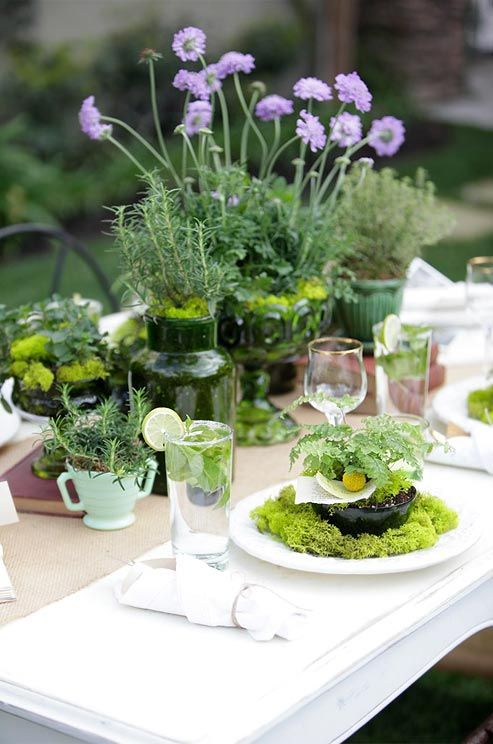
Making a List and Checking It Twice
Once you’ve picked out your flowers and herbs, make a list of all the floral arrangements you’d like to include them in. Start, of course, with the bridal bouquet. As the queen of the day, the bride simply glows with romance, and her bouquet should reflect both her personal style and her deeper beliefs, as spoken through the language of flowers.
The bride’s bouquet sets the tone for the rest. All the other designs, from altar flowers to bridesmaids’ bouquets, should follow her lead. Typical wedding arrangements include the bridal bouquet and bridesmaids’ bouquets, the maid of honor’s bouquet, flower girl bouquets or pomanders, boutonniéres for the male members of the wedding party, small nosegays or corsages for the mothers of the bride and groom, and additional corsages or boutonniéres for any special and honored guests such as grandparents, godparents or aunts and uncles.
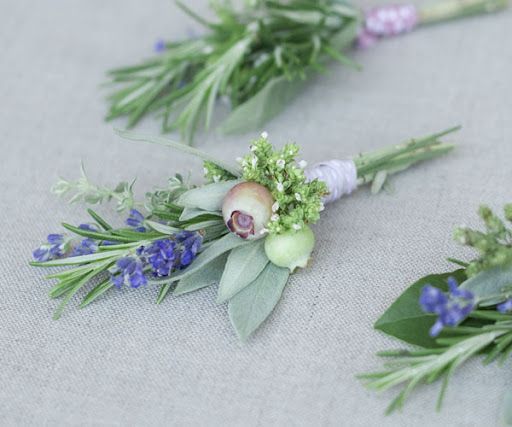
Of course, more obvious elements such as the layout of the ceremony and reception site will play a big role in what flowers you choose. You can choose sleek and simple arrangements, such as two vases of flowers and herbs on the altar. Or you could opt for larger, more complex designs scattered throughout the sanctuary and reception hall. With a larger budget, each table might have a structured floral centerpiece, but for simple yet elegant look, simply scatter loose herbs and flowers over your table linens.
Popular Choices for Herbs
As the very essence of romance, an herbal wedding envelops the senses. The mingled aroma of herbs and flowers together intrigues the nose. The beauty of fresh botanicals beckons the eye. The spiked stems of lavender both blend and contrast with velvety rose petals, creating a coupling that’s as individual as the bride and groom. The symbolism of flowers and herbs overlay the senses, which in the final reckoning adds a deeply personal dimension to the celebration.
The heart of every wedding is joy and happiness, romantic love, and the realities of two people joining their lives to create one story as a couple. Herbs and flowers have always been part of the equation. Here’s what the flower books have to say about them:
Herbs of Bliss
- Sweet marjoram, a Greek symbol of joy and happiness, represents goodwill as the couple starts a new life.
- Heartsease, with its cheerful face, stands for happiness. The muted peaches, pastel yellows, creams, and pinks join with traditional purple to add a “happy face” to bouquets.
- Burnet (or salad burnet) means a merry heart. The pink blooms and attractive foliage combines beautifully with other flower and herbal varieties.
- Mugwort, a midsummer herb, stands for the happiness of the day and the years to come.
- Parsley, especially the curled type, looks charming in bouquets. Parsley’s deep green color creates a cool backdrop against the vibrant hues of roses. In the language of flowers, parsley stands for festivities.
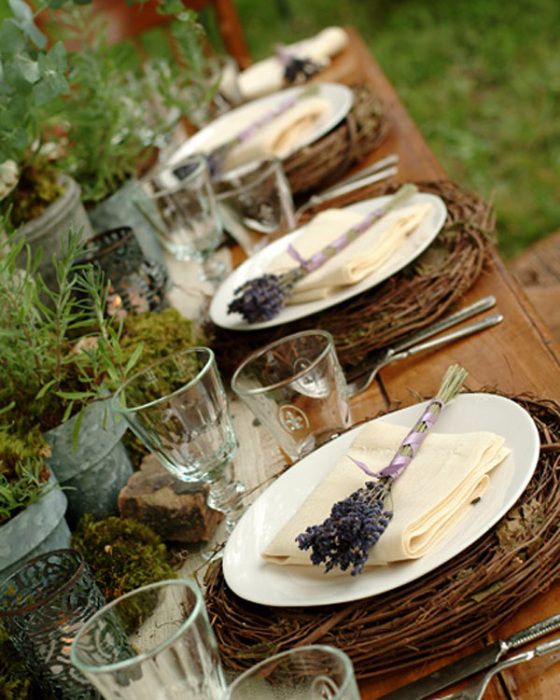
Herbs of Romantic Love
- As everyone knows, red roses mean love. The giver of three red roses says, “I love you passionately.”
- Pink roses suggest gentility, grace, and high romance.
- Yellow roses speak to the gladness of heart in loving another.
- White roses say, “I’m worthy,” and stand for purity. The understated elegance of the white rose makes it a timeless bridal choice.
- Blue salvia says, “I think of you,” and makes an enchanting addition to the bride and groom’s floral arrangements.
- From ancient times on, myrtle has meant love and passion. Closely tied with Aphrodite, true myrtle can be tough to find in cooler parts of the world, but ask around at floral shops and herb farms.
- Lavender means devotion, with its nostalgic fragrance and purple blooms. Lavender is another fine choice for the couple’s floral arrangements.
Herbs for Lasting Togetherness
- Ladies tucked sprigs of thyme into the armor of knights due for battle. Thyme symbolizes strength and courage.
- Beautiful blue-green rue is the herb of grace. In the language of flowers, it stands for vision and virtue.
- Chamomile’s tiny daisy-like blooms and sweet apple scent makes it perfect for weddings. A marriage requires patience, which is precisely what chamomile stands for.
- Add a dusty sprig of sage to bouquets for long life, good heath, and domestic sweetness.
Of course, no herbal wedding would be complete without rosemary. This ancient herb of remembrance deserves a spot in all your bouquets and floral designs. Give rosemary pride of place in two large pots guarding the entrance to the church, on either side of the altar, or at the reception entrance, to greet each guest with its memorable scent. Weave dried rosemary into the herbal mix for tossing when the happy couple leaves. And when all’s said and done, the bride and groom should bring a pot home to remember their day of joy.
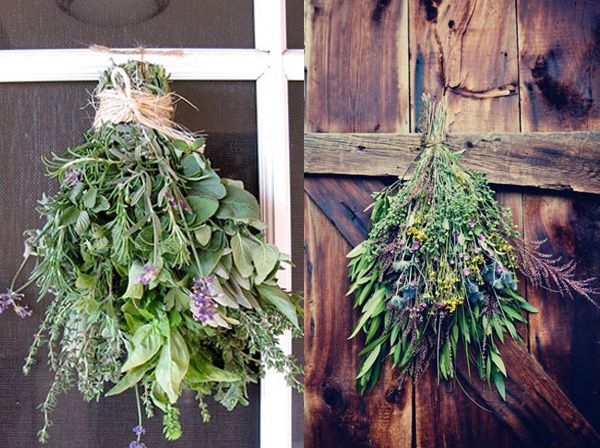
Final Thoughts
Your personal touches become all the more meaningful when you allude to your chosen flowers and herbs in your wedding program. Don’t forget to describe their significance. After all, your wedding’s an occasion to share the deeper meanings you bring to it as well as the fun of a celebration.
Or as a quote from 1607 put it: “Let this rosemary, this flower of men, be a sign of your wisdom, love, and loyalty, to be carried not only in your hands — but in your heads and hearts.”


